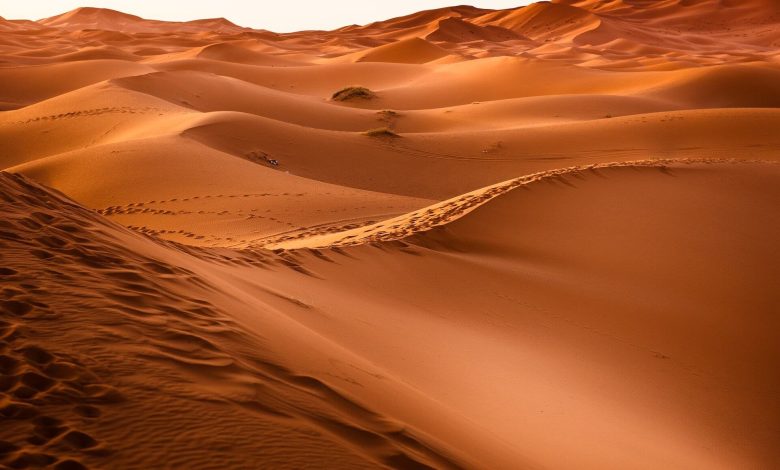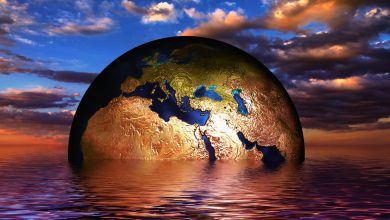The 16 Most Fascinating and Surprising Deserts in the World

The most distinctive feature of a desert biome is that it receives extremely little precipitation and is vast in size. This most defining feature of deserts closely affects the landscape, the plants and animal species that live there, and the way they interact. Although deserts are arid and seemingly barren lands, they can also be places with quite striking biodiversity as plants and animals adapt to this harsh environment. This article contains information on some of the Earth’s most fascinating and surprising deserts.
United States Mojave Desert
Rugged mountains and deep basins form the main landscapes of the Mojave, which stretches east of California’s Sierra Nevada range to southern Nevada. The Mojave is the smallest of North America’s four deserts, a transition zone between the warmer Sonoran desert and the colder Great Basin. Volcanic fields, dunes, and cone-shaped alluvial fans or bajadas are other highlights.
The Mojave is home to Death Valley, the lowest, driest, and hottest place in the United States. Remarkably, thousands of plant and animal species live here, including the iconic Joshua tree. Animals include rodents, rabbits, coyotes, desert tortoises, scorpions, snakes, great horned sheep, and mountain lions.
United States and Mexico Sonoran Desert
The Sonoran Desert covers most of southern Arizona, as well as Sonora, Mexico, southeastern California, and Baja California. But within this vast area are subdivisions with distinctive altitudes, climates, geology, vegetation, and wildlife. The symbolic saguaro cactus and the mesquite tree are among the prominent flora. Larger mammals include the javelin, Mexican wolves, coyotes, bighorn sheep, and lynxes. Horned lizards, turtles, gila monsters, tarantulas and scorpions are among the varieties of wildlife found here.
United States Great Basin Desert
This high-altitude Great Basin Desert is the only cold desert in North America, with hot summers and cold winters. It covers most of Nevada, parts of California, Oregon, Idaho, and Utah, and consists of varying mountains and basins, including the Great Salt Lake. While sage dominates its basins, each mountain range is an isolated island of biodiversity with species such as pine, spruce, and aspen. The Great Basin is home to wild mustang as well as deer and antelope.
United States and Mexico Chihuahuan Desert
Covering the US-Mexico border regions and extending into central Mexico, the Chihuahuan Desert is the most diverse in the Western Hemisphere and the largest in North America. It stretches from central New Mexico south to White Sands National Park and the Guadalupe Mountains, continuing through Chihuahua and five other Mexican states. Mesas and mountains border desert valleys that are home to agave, gypsum and more than 400 species of cacti. It is home to a variety of wildlife, including mountain lions, endangered Mexican wolves, black-tailed prairie dogs, foxes and mule deer.
Colombian Guajira Desert
the Guajira desert; It is located at the Guajira peninsula exit of Colombia, which crosses into Venezuela, a country associated with lush, tropical landscapes and foggy cloud forests. On the top of the South American continent, on a narrow piece of land that stretches into the Caribbean, La Guajira has red-orange sand dunes, salt flats, and rocky coastal cliffs. It contrasts with the occasional lush wetlands including seas and flamingos that support a variety of life including these. La Guajira is home to opossums, rabbits, deer, dozens of reptiles and 145 bird species. Featured vegetation includes legumes, thorn bushes, and a variety of cacti.
Chile Atacama Desert
For a thousand miles, the Atacama desert stretches along Chile’s northern coast, stretching as far as Peru, Bolivia and Argentina. It is one of the driest places on Earth and supports very little life. However, some species can adapt here despite extremely harsh conditions. For example desert fauna such as scorpions, butterflies, wasps, Atacama frog, lava lizards and iguanas. Mineral-rich landscapes include salt flats and geysers, volcanic formations, and even lagoons where many birds live or migrate, including sparrows, hummingbirds and Andrean flamingos. Humboldt penguins, seals and sea lions can also be seen along the coast.
Argentina Patagonia Desert
The Patagonian desert is a cold desert steppe, a series of descending plateaus from the Andes to the Atlantic coast of Argentina. Some parts are extremely dry and rocky, while others are covered with shrub plants adapted to dry winds and frost throughout the year. One of the most unusual species out there is the pillow plant, which looks like a large, bumpy pillow made of soft moss. Mammals that live here include ferrets, opossums, foxes, cougars, and the guanaco, a close relative of the llama.
Antarctica Antarctic Desert
Of all the deserts on earth, perhaps the most surprising is Antarctica. But it hardly ever rains or snows here, and when it does, it’s so cold here that the snow accumulates as ice instead of melting. There are no trees or shrubs outside the coastal areas, only algae and algae adapted to the extreme cold. Antarctic wildlife includes several species of penguins, seabirds, whales and seals. However, far from the coast, the vast continent is largely lifeless.
Namibia Namib Desert
Stretching up and down Namibia to reach Angola and South Africa, this out-of-this-world landscape of sand, rock and mountain is home to the Skeleton Beach, famous for its shipwrecks caused by rough surf and heavy fog. However, this fog makes this arid region suitable for life. Creatures living in the Namib Desert have adapted well here. Mist, insufficient moisture from the soil and air, and harvest insects, as well as perennial plants such as Welwitschia mirabilis, live best here. Perhaps most notable is the megafauna in these brutal lands, including lions, mountain zebras, and desert elephants with an extraordinary ability to find water.
South African Kalahari Desert
Stretching across Botswana, Namibia, and parts of South Africa, the Kalahari is South Africa’s largest desert. Endemic plants here include the Hoodia cactus, which thrives in extremely high temperatures, and the thistle tree, an acacia that is an important source of food and shade for wildlife. The fierce Kalahari, a subspecies of a lion, has unique characteristics due to its adaptations, and an antelope called gemsbok can live without water for weeks. Meerkats consume scorpions, snakes and other poisonous creatures without being poisoned.
North African Sahara Desert
Occupying 11 countries in North Africa, the Sahara is the world’s largest hot desert. The northernmost region includes mountains, volcanic fields, iconic dunes and oases. While the fertile Nile Valley lies in eastern Sahara, the extremely dry central region is largely devoid of vegetation. They live in the Sahara along with endangered species such as gazelles, African wild dogs, camels, jackals, Algerian porcupines, African wild asses, hyenas, Saharan cheetah, leopard and North African ostrich.
Middle East Syrian Desert
The Syrian Desert encompasses eastern Jordan, southern Syria, and western Iraq within the Mesopotamian scrub desert ecoregion, which is mostly a transitional area of rocky and sandy plateaus. Jordan also includes the Black Desert filled with volcanic basalt stones with petroglyphs. This is an indication that there was plenty of water and trees before. The Syrian Desert is home to resilient, resourceful wildlife, but is threatened by drought, overgrazing and conflict. Cheetahs have suffered significant biodiversity loss, including ostriches and wolves.
Arabian Peninsula Arabian Desert
The Arabian Desert dunes stretch across most of the Arabian Peninsula, boasting innovative adaptations of flora and fauna. The ghaf tree has roots about 100 feet long to access water deep below the surface. The scrubbed Ghada stabilizes the dunes and provides shade to many animals. Wildlife includes oryx, gazelles and resourceful sand cats. Surface springs are rare, but the desert sits above a vast aquifer, containing refreshing pools and numerous palm-filled oases.
China and Mongolia Gobi Desert
The Gobi Desert is a rain shadow desert nestled along the Himalayas and two small mountain ranges. It is the world’s fifth-largest and also the fastest-growing desert. Adjacent grasslands are being destroyed by massive deforestation and erosion caused by climate change. With hot summers and extremely cold winters, the Gobi ranges from sand dunes to grasslands and steppes. Wildlife here includes grizzly bears, Asian wild asses, gazelles, wild Bactrian camels, and endangered snow leopards in the mountains.
Spain Tabernas Desert
The Tabernas desert, in the province of Almeria in southern Spain, is probably Europe’s only true desert. There is a lot of precipitation here, which creates barren lands and arroyos with sudden showers. In winter, the delicate white flowers of toadflax linaria dot the dry land and are home to rabbits, yurts and Algerian hedgehogs. Also, frogs, toads, and turtles live in wetlands, while ladder snakes, green ocellated lizards, tarantulas, and scorpions crawl on the sand.
Australian Deserts
Australia has 10 distinct deserts that collectively cover one-fifth of the continent and form part of the vast inner Outback. The Great Victoria Desert is the largest, among others the Great Sandy Desert, the Small Sandy Desert, the Gibson Desert and the Western Desert. The waterholes scattered across this challenging terrain are home to an abundance of wildlife, from amphibians and marsupials such as endangered rock wallabies, billies and kangaroos, to pink cockatoos, bats, dingoes and numerous species of lizards, spiders and snakes.





